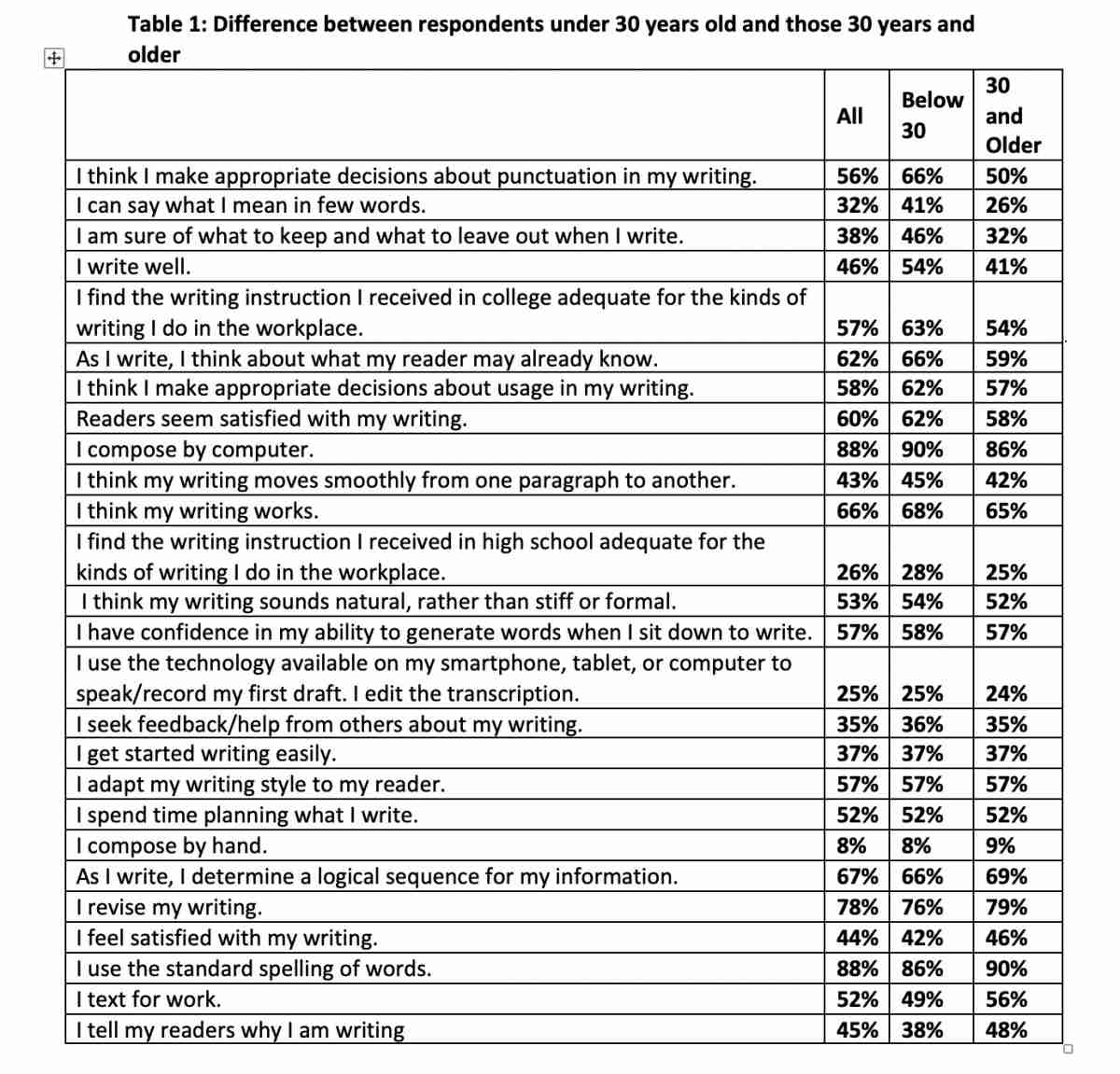This article is co-authored by Wilma Davidson, Ed.D.; Laura Hoffman, M.A.; and Thorold (Tod) Roberts, A.B.D.
In 2014, we surveyed more than 250 working professionals about their insights into their own workplace writing. After analyzing the responses, we suggested pragmatic ways for college students and others to improve their business and technical correspondence. (See “Get It In Writing: New Survey Reveals Paradoxes About Workplace Writers” at https://writingcommons.org.) Among the results showcased then was the indication that working professionals bounce between a mix of uneasiness and confidence when they write—and they ultimately still struggle to define and deliver their messages to others.
As a result of that study, we wanted to know more:
- Were responses skewed by age?
- What effect did the available technology and apps have on writing effectiveness and ease of writing?
- Was writing instruction received in high schoolor in college adequate for writing in the workplace?
We added questions to the original survey to discover whether age or perceptions of high school and college writing instruction played a significant role in the participants’ perceptions of their writing.
Survey Demographics
The 26-question survey was completed by a mix of 247 professionals fitting this profile:
- Males and females
- Ages 21 to 60-plus
- Employed from several weeks to more than 30 years
- College graduates (earners of Bachelor’s, Master’s, or doctorate degrees)
- All levels of management
- Employed at global companies that range in annual revenue from $2 billion to $40 billion
- Representing varied industries such as consumer products, pharmaceuticals, technology
- Representing varied business functions such as accounting, engineering, communications, sales, marketing, finance, training, research and development, and information technology (IT)
- From many locations throughout the U.S.
Survey Findings
Our findings replicate, in many instances, the findings of the 2014 study. Most intriguing, however, were these results:
- Millennials (workers under age 30) rated their writing expertise slightly higher than older workers (30-plus) in several categories (see summary table below). Most notable were the statistically significant differences in the under-30 respondents’ perceptions of their 1) Being able to say what they want in few words; and 2) Choosing correct punctuation. These findings raised the question of whether this generation of workers grew up having a more positive attitude about themselves because they appeared less self-critical than the over-30 crowd. Still, only 46 percent of all workplace writers rated themselves as writing well.
- Those in all age categories (under 30, 30 to 50, and over 50) still struggle with getting started, feeling confident about, and being satisfied with their writing. This makes us wonder what their teachers did—or didn’t do—to build their students’ sense of authorship and self-confidence.
- While the majority of those in all age categories use the computer to get started, only 25 percent take advantage of Siri and other apps that invite workplace writers to have their talk transcribed immediately into text from the computer, tablet, phone, and even smartwatch! This percentage is up significantly from the 4 percent in the 2014 survey who avail themselves of speech-to-text technology, but one might expect tech-savvy Millennials raised to expect instant gratification to be “talking text” in even greater numbers just to save time.
- Only 35 percent of all respondents seek feedback from others on their writing. This leads us to ask whether the nature of today’s “workplace” is partially responsible. Many people work remotely without access to a colleague in the next office or without the wise habit of always having another pair of eyes review their work. Even though Millennials are team oriented, they do not seem to transfer this to having part of their team review their written work.
- More than 50 percent of all respondents said the writing instruction received in college was adequate, but this leads us to ask why 50 percent said it wasn’t.
- Only 26 percent of all respondents perceived the writing instruction they received in high school to be adequate, but this leaves 75 percent saying or implying it was not.

These findings, across all age groups, led us to look not so much at the individual responses of the nearly 250 survey participants but rather at how their perceptions as a group reflect the quality of writing instruction across the United States. The survey findings reported by us in 2014 and again in 2018 support a need for improvement in writing instruction that will reverse the well-documented and dismaying decline in writing skills—in both academic settings and corporate offices.
Implications of the Findings
That writing quality has declined already has been well-documented elsewhere. Research conducted by the Association of American Colleges and Universities (AACU) and the National Association of Colleges and Employers (NACE) has reported that more than 75 percent of employers want a stronger focus on written communication skills at the college level—they want future workers to master writing skills that can transfer easily out of the classroom to the workplace. But becoming an able writer should start much earlier.
The National Association of Education Progress (NAEP), in its 2011 “report card” to the nation, reported that only 27 percent of 8thand 12thgraders were considered proficient writers. Further, they reported that 40 percent of those taking the ACT exam are incapable of successfully completing a college-level English composition course.
Why do such results continue to occur?
Getting Closer to the Root Cause
Although we initially thought our hypothesis might lead us to see significant differences in writing perceptions based on respondents’ age, we found only a few responses that seemed to correlate with age. We realized the reason “Johnny and Jane can’t write” may not lie with the responders to our survey, but with their past teachers, with teacher quality, and with teacher preparation. To support our speculation, we present these observations:
- The Carnegie Institute’s Writing Next (2007) concludes that many teachers lack the formal preparation needed to teach writing and modeling of effective communication.
- The 2016 National Study of Writing Instruction in Teacher Education Programs similarly reports a lack of attention to teacher preparation. https://scholarworks.boisestate.edu/cgi/viewcontent.cgi?referer=https://search.yahoo.com/&httpsredir=1&article=1169&context=cifs_facpubs
- Lack of teacher self-confidence may belie the motivation to teach writing as does a teacher’s attitude toward the teaching of writing. Without self-confidence and a positive attitude about their mission, teachers can’t inspire their students. This lack of teacher self-confidence about and positive attitude toward writing spreads beyond the English teacher. Every subject matter teacher must model and value the written word for students to be truly inspired.
- The National Council of Teachers of English (NCTE) found little evidence in a 2016 survey of 2,400 teachers’ syllabi that teaching of writing was being covered in a widespread or significant way. https://www.nytimes.com/2017/08/02/education/edlife/writing-education-grammar-students-children.html
- A separate 2016 study of 500 teachers, conducted by Gary Troia of Michigan State and Steve Graham of Arizona State University found that fewer than half the teachers had taken a methods course in the teaching of writing, and fewer than a third had taken a class devoted to how children learn to write. It is no surprise, given this data, that only 55 percent of teachers responding said they enjoyed teaching writing. https://www.nytimes.com/2017/08/02/education/edlife/writing-education-grammar-students-children.html
- Nearly 75 percentof teachers say writing instruction is embedded in their reading courses, but that there are few methods courses devoted to the teaching of writing and there is little time to teach writing in the classroom. https://scholarworks.boisestate.edu/cgi/viewcontent.cgi?referer=https://search.yahoo.com/&httpsredir=1&article=1169&context=cifs_facpubs
- Importantly, where are the methods courses for teachers to help students learn to write before they enter the workplace? In February 2016, NCTE prepared a Position Statement offering guidelines on Professional Knowledge for the Teaching of Writing. Have these been acted upon?
- Additionally, a search of high school English offerings will show literature, film, journalism, and creative writing classes. But are there any business writing classes where students can learn to write for real purposes to real audiences?
- Where do students learn to pay attention to their audience’s information needs, to use better editing strategies, to provide and offer feedback to others? They have been used to writing to please the teacher for a grade but for no pragmaticpurpose, and they have little opportunity for feedback beyond correction of mistakes.
- Where do teachers learn to recognize and model good writing and give useful feedback? Assigning writing and correcting errors is not the same as teaching writing.
Teachers themselves need courses in professional writing and in the teaching of such writing. If there is a stigma attached to “business writing” as a genre less worthy than “academic writing,” then that stigma needs to be overcome. Students and their future employers should be able to communicate in both traditional written composition and in modern digital technology with clients, customers, staff, and managers. We believe this mission deserves attention at the highest levels in college departments of education, liberal arts, business, and the STEM (science, technology, engineering, and mathematics) fields.
It’s not that students are poor writers. Many simply haven’t been prepared to do the kind of writing needed in their futures. We’ve been wrapped up so long in Johnny and Jane’s inability to write that we have missed the point: Our best hope is an overhaul of teacher preparation.
This article is co-authored by Wilma Davidson, Ed.D.; Laura Hoffman, M.A.; and Thorold (Tod) Roberts, A.B.D.
In addition to being an instructor of Professional and Technical Communication at the University of South Florida Sarasota-Manatee, Wilma Davidson, Ed.D., is president of communications consulting firm Davidson & Associates. She works with a wide range of Fortune 500 companies to overcome the written and oral communication challenges confronting them. Additionally, she has authored several books on the art of communicating, including “The Third Revision: Business Writing: What Works, What Won’t.”
Laura Hoffman, M.A., currently serves as director of Institutional Research and Effectiveness at the University of South Florida Sarasota-Manatee. Hoffman has responsibility for decision support, institutional effectiveness, and federal/state/local reporting. She holds a Master’s degree in Educational Research and Measurement and is a doctoral student in the USF College of Education working on her dissertation.
Thorold (Tod) Roberts, A.B.D., is an instructor of Professional and Technical Communication at the University of South Florida Sarasota-Manatee. He has combined his academic training in literature and language with a 40-year career as a teacher, professional writer, editor, and consultant serving employers and clients in management consulting and other professional disciplines. His publications range from military history to technical studies in accounting, architecture, corporate logistics, and information technology.




